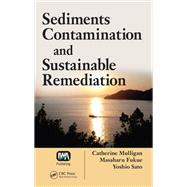
Note: Supplemental materials are not guaranteed with Rental or Used book purchases.
Purchase Benefits
Looking to rent a book? Rent Sediments Contamination and Sustainable Remediation [ISBN: 9781420062236] for the semester, quarter, and short term or search our site for other textbooks by Catherine N. Mulligan; Masaharu Fukue; Yoshio Sato. Renting a textbook can save you up to 90% from the cost of buying.
| Introduction to Sediment Contamination and Management | |
| Introduction | |
| Sustainable Development and the Aquatic Geoenvironment | |
| Sources of Pollutants | |
| Management of Contaminated Sediments | |
| Natural Mitigation Processes | |
| Bioaccumulation of Contaminants | |
| Sustainable Sediment Management Practices | |
| Concluding Remarks | |
| References | |
| Introduction to Sediments | |
| Introduction | |
| Definition of Sediments | |
| Types of Sediments | |
| Benthos | |
| Uses of Sediments and Water | |
| Management of Sediments | |
| Concluding Remarks | |
| References | |
| Contaminant-Sediment Interactions | |
| Introduction | |
| Factors Influencing Contaminant-Sediment Interactions | |
| Sorption of Pollutants and Partition Coefficients | |
| Biotransformation and Degradation of Organic Chemicals and Heavy Metals | |
| Interaction of Contaminants, Organisms, and Sediments | |
| Chemical Reactions, Geochemical Speciation, and Transport Predictions | |
| Concluding Remarks | |
| References | |
| Remediation Assessment, Sampling, and Monitoring | |
| Introduction | |
| Cleanup Goals and Background Values | |
| Sampling | |
| Analysis and Evaluation | |
| Case Studies | |
| Concluding Remarks | |
| References | |
| Natural Recovery of Contaminated Sediments | |
| Introduction | |
| Natural Recovery Processes of Sediments | |
| Evaluation of the Natural Recovery of Sediments | |
| Models for Natural Remediation | |
| Regulatory Framework | |
| Protocols Developed for Monitored Natural Recovery | |
| Case Studies of Natural Recovery | |
| Enhanced Natural Recovery | |
| Concluding Remarks | |
| References | |
| In Situ Remediation and Management of Contaminated Sediments | |
| Introduction In Situ Capping | |
| Rehabilitation of the Coastal Marine Environment | |
| Chemical Remediation Technologies | |
| Biological Remediation Technologies | |
| Creation of Seaweed Swards | |
| Case Studies of Remediation | |
| Concluding Remarks | |
| References | |
| Dredging and the Remediation of Dredged Contaminated Sediments | |
| Introduction | |
| Sustainable Dredging Strategies | |
| Physical Remediation Technologies | |
| Chemical/Thermal Remediation | |
| Biological Remediation | |
| Beneficial Use of Sediments | |
| Confined Disposal | |
| Comparison between Treatment Technologies | |
| Case Studies of Remediation | |
| Concluding Remarks | |
| References | |
| Management and Evaluation of Treatment Alternatives for Sediments | |
| Introduction | |
| Generic Framework | |
| Remediation Objectives | |
| Lines of Evidence | |
| Evaluation of the Management Alternatives | |
| Selection of Technologies | |
| Management Plan | |
| Sustainable Remediation | |
| Strategy for Remediated Sediment Sustainability | |
| Concluding Remarks | |
| References | |
| Current State and Future Directions | |
| Introduction | |
| Disposal at Sea | |
| Beneficial Use of Dredged Materials | |
| Sustainability Evaluation | |
| Case Study of Lachine Canal | |
| Barriers to Technology Development and Implementation | |
| Current Needs and Future Directions | |
| Concluding Remarks | |
| References | |
| Sediment Quality Guidelines from Environment Canada and MDDEP, 2008 | |
| London Convention and Protocol: Convention on the Prevention of Marine Pollution by Dumping of Wastes and Other Matter, 1972 | |
| Prediction of Sediment Toxicity Using Consensus Based Freshwater Sediment Quality Guidelines: USGS. 2000 | |
| International Sediment Quality Criteria | |
| Index | |
| Table of Contents provided by Publisher. All Rights Reserved. |
The New copy of this book will include any supplemental materials advertised. Please check the title of the book to determine if it should include any access cards, study guides, lab manuals, CDs, etc.
The Used, Rental and eBook copies of this book are not guaranteed to include any supplemental materials. Typically, only the book itself is included. This is true even if the title states it includes any access cards, study guides, lab manuals, CDs, etc.